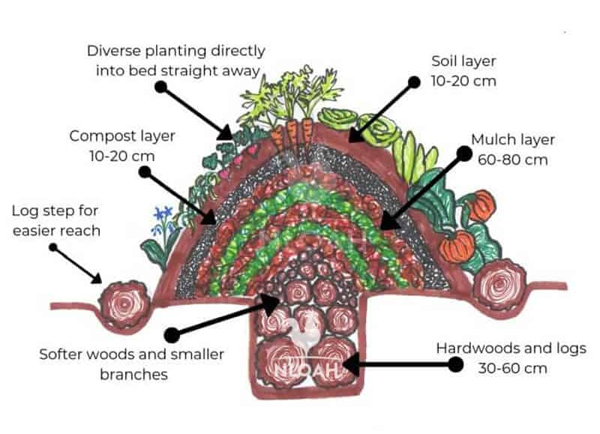
Image courtesy of newlifeonahomestead.com
Hugelkultur. I think it’s the word that initially attracts me. It can make me laugh when I’m tired . . . and when I’m not.
I have referred to the process of building one as “that hugel fugel thing we did” (no disrespect intended). It was a few years back, when a group from the Rutherford County Master Gardeners, under the guidance of one of their own, Richard Lee, spent a few hours on a nippy afternoon building two hugel mounds. Upon the announcement of the learning experience I determined that I was not missing this event filled with knowledge and probable random outbursts of laughter.
Hugel . . . HUUU-gel . . . Hugel-FUGELLL. LOL.
Those hugelkultur mounds are still at the Rutherford County Ag Center, but are not as high as on the day they were built.
The word means hill culture or hill mound. It is built with the same components as a compost pile and completed with topsoil. It is quite easy to build and has a long history of success in Germanic countries. I remember Richard telling us that the mounds should be grouped together. Heat from decomposition within the mound does promote and assist cool crops growing in the winter. The proximity to each other allows fresh vegetables through cold weather.
The basis of a hugelkultur mound is wood—specifically, decaying logs and branches. In their simplest form, mounds are constructed by piling logs, branches, plant waste, compost and soil into a pyramid shape. Straw, cardboard and kitchen waste can be added. Typically, mounds are 3 feet wide, 6 feet deep and 3 feet high. Expect the height to decrease as the “ingredients” settle. You can also dig the area into the ground. The Master Gardener group went down several inches into the selected area before piling the ingredients.
Position hugelkultur beds to receive maximum sun for cool-season plants. Place the mounds closely together. Try to position them counter to the prevailing wind direction. As the pile decays, the created humus retains water and improves soil. There has been some criticism and concern over the speed of decay resulting in over-fertilized beds and too much nitrogen. Sepp Holzer, who wrote a book on permaculture, says to use logs and bigger branches instead of woodchip sizes to avoid this issue.
Another issue arises when the mound is double-purposed as a hugelkultur mound and a swale or berm for water control. Two different purposes should have two different constructions. Don’t do it. It can create destruction of your mound with a good rainfall.
When can you plant in a hugelkultur mound? Well, every mound would have its own answer.
How much soil is within the mound? Did you top-dress it only with soil or is it layered throughout? To me, that would be the key indicator. Assess whether the mound has enough soil for the plants you want to grow. Realize there will be more soil eventually, but it takes time to decay. Right now, can the soil in the mound support your crop?
On a different topic, Tennessee Tree Day is March 20, 2021. The last day to order trees is March 7, and you do need to reserve them. Types available are bald cypress, buttonbush, northern red oak, pecan, redbud, red mulberry, shortleaf pine, silky dogwood, sweetgum, tulip poplar, white oak and wild plum. For more information and to order trees, visit tectn.org/tennesseetreeday2021.html.
Tennessee Tree Day aims to engage Tennesseans of all ages and backgrounds in conservation solutions that will benefit communities for decades to come. Thousands of volunteers will replace trees lost to development, helping to repair degraded streams, improve water quality, restore health to terrestrial and aquatic riparian habitats, increase habitat and forage for wildlife and pollinators, reduce air pollution, improve community aesthetics and enhance Tennessee’s magnificent tree canopy.












